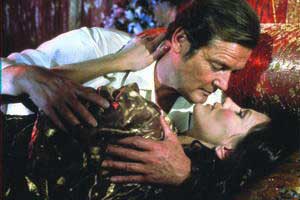In 1983, when dapper spy James Bond 007 landed in sandy Rajasthan in pursuit of a thrilling murder case involving an Indian prince, the Indian sets and locales won high marks at the box office.
The Metro Goldwin-Mayers (MGM) production, Octopussy, starring Roger Moore, Kabir Bedi, Maud Adams and Louis Jourdan, proved a resounding success. Over the years, over one dozen international film icons, including Gregory Peck and Richard Dreyfuss, have acted in films shot in India and several leading directors, such as Jean Renoir and Sir Richard Attenborough, have turned to India in their productions. Virtually all the major Hollywood production houses, such as 20th Century Fox, Lippert Pictures, Oriental International, Columbia Pictures, Channel4, Colombia Tri-Star, HBO/ Columbia, Kaleidoscope Entertainment, Miramax Films, Touchstone Pictures and Universal / Canal Plus, have filmed in India. In 1994, Walt Disney Pictures shot Rudyard Kipling’s Jungle Book in India. Directed by Stephan Summers, the film featured Jason Scott Leed, Sam Neil and John Cleese as lead stars. Starting in 1938, with the shooting of the film, The Drum, at least 45 major foreign films have been shot predominantly in India, the most recent of which was Bourne Supremacy in 2004, starring Matt Damon and Franke Potente. Directed by Paul Greengrass, this film was shot in Goa, and captures stunning scenes of deserts, sea, jungles, overcrowded Indian cities, ancient Portuguese villas, old churches and everyday scenes of Goans nestling under the cool sheds of coconut trees.
The 1938 movie The Drum, about an Indian prince Sabu, directed by Zoltan Korda and starring Raymond Massey and Roger Livesay first introduced foreign film audiences to India. After a lapse of 12 years, four internationally acclaimed films were shot in India in the 1950s: Kim (1950), The River (1951), The Jungle (1952) and Rogue’s March (1953). The pace of foreign films in India picked up markedly between 2001-2004, during which as many as 15 foreign films were shot in the country, including Monsoon Wedding, The Warrior, Bride and Prejudice, Vanity Fair and Bourne Supremacy. Some of these films, which are produced by overseas Indians, did not merely feature India as a backdrop, but rather the story line revolved around Indian culture and mores. Mira Nair’s Monsoon Wedding portrays an arranged marriage in India. The Warrior involves a Rajasthani fighter (Irfan Khan) who moves to the Himalayas in search of peace. Gurinder Chadha’s Bride and Prejudice, starring Martin Henderson and Aisharya Rai, extends Bollywood treatment to Jane Austen’s Pride and Prejudice. Mira Nair also brought a peculiarly Indian touch to the opus Vanity Fair, which featured Reese Witherspoon and Gabriel Byme. Earlier movies shot in India, which have enjoyed international acclaim, include Columbus Tri-Star’s City of Joy, based on Dominique Lapierre’s book on Calcutta. Starring Patrick Sawyze, the film relates an American doctor’s journey in search of peace in the overcrowded streets of Calcutta. Other successful foreign films shot in India include: Last Dance, starring Sharon Stone, Rob Marrow and Randy Quaid and produced by Bruce Beresford; Kamasutra by Mira Nair; Fire by Deepa Mehta; Fire in Paradise, starring Brett Stimely and Christopher Neame; Jane Campion’s Holy Smoke, with Kate Winslet and Harvey Kettel and Ismail Merchant’s Cotton Mary, starring Greta Stacchi.
But by far the film that is most linked to India is Columbia Pictures and Sir Richard Attenborough’s 1982 classic Gandhi, with Ben Kingsley playing Gandhi. The 1980s were a rich decade for Indian locales in foreign films. The decade opened with Sea Wolves (1980), and included such blocbusters as Heat and Dust, Salaam Bombay and Octopussy. The HBO/Columbia production by David Lean, A Passage to India became a film classic with stellar performances by Judy Davis, Alec Guinness and Victor Banerjee, with a storyline revolving around the alleged rape of British girl by an Indian doctor. The 1983 Merchant-Ivory production Heat and Dust, based on the novel by Ruth Prawar Jhavala, with Greta Stacchi and Julian Giover cast in lead roles, presented dramatic Indian imagery to an international audience. Merchant-Ivory have long had a fascination with Indian sets, beginning with Shakespearewallah in 1965. The film, which showcased three Indians performers, Sashi Kapoor, Madhur Jaffrey and Utpal Dutt, centers around a handful of British actors traveling across India staging William Shakespeare plays to raise money to finance their journey back to England. Merchant-Ivory also shot Bombay Talkie in 1970, with Sashi Kapoor and Jeniffer Kendal and Hullabaloo in 1978 with Peggy Ashcroft and Larry Pine.
Many of the foreign films offered panoramic views of Indian life to an overseas audience for the first time. Sea Wolves, featuring Gregory Peck, Roger Moore and David Niven, vividly captures the ancient Portuguese colony of Goa. Mira Nair’s Salaam Bombay (1998) captures the life of Mumbai’s street children and of course City of Joy will forever remain an ode to Calcutta. Calcutta was also the setting of Jean Renoir’s first celluloid venture in color, titled The River (1951). The film’s story revolved round three adolescent girls in Calcutta, soon after the end of Second World War in 1945. The doyen of Indian cinema, Satyajit Ray, collaborated with Renoir on the film. Among the most dramatic movies shot in India is the 1997 film Close Encounters of The Third Kind, starring Richard Dreyfuss and directed by Stephen Spielberg, which is set in India, Alabama and Wyoming. But then, few movies can beat the images from 35 years earlier in MGM’s and John Guillermin’s Tarzan Goes to India (1962), starring Jock Mahoney and Leo Gordon
|
Looking In, Seeing Out

